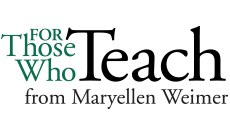The “find and replace” feature in Word quickly makes an old syllabus ready for a new course. Use it too many times and thinking about the course settles into a comfortable rut. Yes, we may change more than just the dates, but when was the last time we considered something beyond what needs to go on the syllabus? The literature answers that question with a few definitive conclusions and a host of possibilities. Here are some thoughts, offered with just a bit of provocation, in the hopes they might reenergize our thinking about the syllabus and what it can accomplish in the course, for students and for the teacher.
 Tone matters as much as content.
Tone matters as much as content. On most syllabi the tone is professional, impersonal, directive, often more negative than positive and more accusatory than encouraging. It’s language that accomplishes two objectives: it clarifies expectations and establishes who’s in charge. Most syllabi would not be described as friendly invitations to exciting learning adventures.
Does the tone matter? Is a more positive tone preferred? Harnish and Bridges (2011) created two versions of a syllabus that contained the same content, but one was written in a cold tone, the other in a warm one. There are examples of each in the article. “Our results revealed that a syllabus written in a friendly tone had a significant impact on how the instructor was perceived.” (p. 326) Richmond, et. al. (2016) used learner-centered and teacher-center syllabi in their research (characteristics of each appear in Table 1, p. 4). “Student perceptions of [hypothetical] faculty using a learner-centered syllabus were markedly more positive; they rated faculty as creative, caring, happy, receptive, reliable and enthusiastic as well as having more student engagement in their class than faculty using a teacher-centered syllabus.” (p. 1)
Downsize policies. Yes, this is the provocative part but there are two issues here that merit some mulling over. First, policy creep, defined as the addition and retention of a policy that prohibits something bad that happened once, affects many syllabi. What’s the ratio between what the syllabus decrees students shouldn’t do and what it proposes they should do? Rules are fine but a plethora of prohibitions dampen the motivation to learn.
Second, an instructor’s credibility suffers if the syllabus contains a policy that can’t or won’t be enforced. Cell phone policies are a great example. There’s lots of research documenting that better than 90% of students are using their phones in class, even in courses with a policy that prohibits their use (see Clayson and Haley, 2013, for example). Students also report that if the instructor asks them to stop using the phone they will, at that time, but will continue to use the phone in that and other courses. The distracting use of cell phones is a problem, but it’s not being prevented by most policies and that implicates the professor.
Think more like a map and less like a contract. The contract syllabus makes clear what the student is obligated to provide. Does it also list what the professor will provide? Do students get to offer any input? Do they have any recourse? How effectively do contracts motivate learning? Most aren’t very fun to read or easy to understand. Maps, on the other hand, show the way—how to get to where you’re going. Usually there’s more than one route. Maps are helpful, full of all kinds of useful information. If you’re lost, confused, and need directions, you’ll do much better with a map than a contract.
The syllabus can make you a better teacher. Here’s a couple of ways the syllabus can benefit teaching. It’s an artifact that allows the teacher to step back and take a look at the course. There it is, all together in one place. How does it look? Interesting? Cohesive? How well does it all hang together? Where does it start and end? And then there’s useful feedback to be had if questions are asked about the syllabus. Share it with a colleague and ask what he or she would conclude about the course and instructor if all they had to go on was the syllabus. Better yet, ask students.
For more on writing an effective syllabus, read:
References: Harnish, R. and Bridges, K. R. (2011). Effect of syllabus tone: students’ perceptions of instructor and course.
Social Psychology Education, 14, 319-330.
Richmond, A., Slattery, J., Mitchell, N., Morgan, R. and Becknell, J. (2016). Can a learner-centered syllabus change students’ perceptions of student-professor rapport and master teacher behaviors.
Scholarship of Teaching and Learning in Psychology, 2( 3), 159-168
Clayson, D. and Haley, D. (2013). An introduction to multitasking and texting: Prevalence and impact on grades and GPA in marketing classes.
Journal of Marketing Education, 35 (1), 26-40.
© Magna Publications. All rights reserved.







 Tone matters as much as content. On most syllabi the tone is professional, impersonal, directive, often more negative than positive and more accusatory than encouraging. It’s language that accomplishes two objectives: it clarifies expectations and establishes who’s in charge. Most syllabi would not be described as friendly invitations to exciting learning adventures.
Does the tone matter? Is a more positive tone preferred? Harnish and Bridges (2011) created two versions of a syllabus that contained the same content, but one was written in a cold tone, the other in a warm one. There are examples of each in the article. “Our results revealed that a syllabus written in a friendly tone had a significant impact on how the instructor was perceived.” (p. 326) Richmond, et. al. (2016) used learner-centered and teacher-center syllabi in their research (characteristics of each appear in Table 1, p. 4). “Student perceptions of [hypothetical] faculty using a learner-centered syllabus were markedly more positive; they rated faculty as creative, caring, happy, receptive, reliable and enthusiastic as well as having more student engagement in their class than faculty using a teacher-centered syllabus.” (p. 1)
Downsize policies. Yes, this is the provocative part but there are two issues here that merit some mulling over. First, policy creep, defined as the addition and retention of a policy that prohibits something bad that happened once, affects many syllabi. What’s the ratio between what the syllabus decrees students shouldn’t do and what it proposes they should do? Rules are fine but a plethora of prohibitions dampen the motivation to learn.
Second, an instructor’s credibility suffers if the syllabus contains a policy that can’t or won’t be enforced. Cell phone policies are a great example. There’s lots of research documenting that better than 90% of students are using their phones in class, even in courses with a policy that prohibits their use (see Clayson and Haley, 2013, for example). Students also report that if the instructor asks them to stop using the phone they will, at that time, but will continue to use the phone in that and other courses. The distracting use of cell phones is a problem, but it’s not being prevented by most policies and that implicates the professor.
Think more like a map and less like a contract. The contract syllabus makes clear what the student is obligated to provide. Does it also list what the professor will provide? Do students get to offer any input? Do they have any recourse? How effectively do contracts motivate learning? Most aren’t very fun to read or easy to understand. Maps, on the other hand, show the way—how to get to where you’re going. Usually there’s more than one route. Maps are helpful, full of all kinds of useful information. If you’re lost, confused, and need directions, you’ll do much better with a map than a contract.
The syllabus can make you a better teacher. Here’s a couple of ways the syllabus can benefit teaching. It’s an artifact that allows the teacher to step back and take a look at the course. There it is, all together in one place. How does it look? Interesting? Cohesive? How well does it all hang together? Where does it start and end? And then there’s useful feedback to be had if questions are asked about the syllabus. Share it with a colleague and ask what he or she would conclude about the course and instructor if all they had to go on was the syllabus. Better yet, ask students.
For more on writing an effective syllabus, read:
Tone matters as much as content. On most syllabi the tone is professional, impersonal, directive, often more negative than positive and more accusatory than encouraging. It’s language that accomplishes two objectives: it clarifies expectations and establishes who’s in charge. Most syllabi would not be described as friendly invitations to exciting learning adventures.
Does the tone matter? Is a more positive tone preferred? Harnish and Bridges (2011) created two versions of a syllabus that contained the same content, but one was written in a cold tone, the other in a warm one. There are examples of each in the article. “Our results revealed that a syllabus written in a friendly tone had a significant impact on how the instructor was perceived.” (p. 326) Richmond, et. al. (2016) used learner-centered and teacher-center syllabi in their research (characteristics of each appear in Table 1, p. 4). “Student perceptions of [hypothetical] faculty using a learner-centered syllabus were markedly more positive; they rated faculty as creative, caring, happy, receptive, reliable and enthusiastic as well as having more student engagement in their class than faculty using a teacher-centered syllabus.” (p. 1)
Downsize policies. Yes, this is the provocative part but there are two issues here that merit some mulling over. First, policy creep, defined as the addition and retention of a policy that prohibits something bad that happened once, affects many syllabi. What’s the ratio between what the syllabus decrees students shouldn’t do and what it proposes they should do? Rules are fine but a plethora of prohibitions dampen the motivation to learn.
Second, an instructor’s credibility suffers if the syllabus contains a policy that can’t or won’t be enforced. Cell phone policies are a great example. There’s lots of research documenting that better than 90% of students are using their phones in class, even in courses with a policy that prohibits their use (see Clayson and Haley, 2013, for example). Students also report that if the instructor asks them to stop using the phone they will, at that time, but will continue to use the phone in that and other courses. The distracting use of cell phones is a problem, but it’s not being prevented by most policies and that implicates the professor.
Think more like a map and less like a contract. The contract syllabus makes clear what the student is obligated to provide. Does it also list what the professor will provide? Do students get to offer any input? Do they have any recourse? How effectively do contracts motivate learning? Most aren’t very fun to read or easy to understand. Maps, on the other hand, show the way—how to get to where you’re going. Usually there’s more than one route. Maps are helpful, full of all kinds of useful information. If you’re lost, confused, and need directions, you’ll do much better with a map than a contract.
The syllabus can make you a better teacher. Here’s a couple of ways the syllabus can benefit teaching. It’s an artifact that allows the teacher to step back and take a look at the course. There it is, all together in one place. How does it look? Interesting? Cohesive? How well does it all hang together? Where does it start and end? And then there’s useful feedback to be had if questions are asked about the syllabus. Share it with a colleague and ask what he or she would conclude about the course and instructor if all they had to go on was the syllabus. Better yet, ask students.
For more on writing an effective syllabus, read: